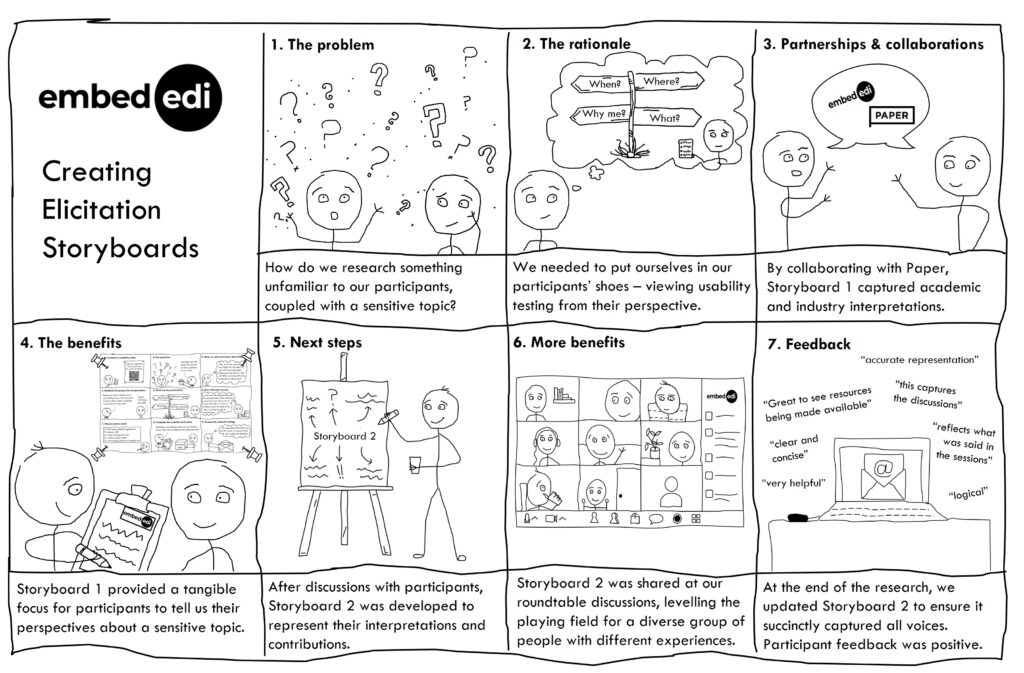Facilitating Equality, Diversity and Inclusion in Collaborative Research: How Elicitation Storyboards Help
Facilitating Equality, Diversity and Inclusion in Collaborative Research: How Elicitation Storyboards Help
Jo McKenna-Aspell, Sophie Rutter, Cam Spillman, Yuhua Wang, Efpraxia D. Zamani
How can we foster equitable discussions between different groups of people with very different backgrounds and experiences? In our study on embedding equality, diversity and inclusion (EDI) in usability testing we used storyboards to facilitate collaboration between people who are underrepresented in usability testing with usability researchers. We discuss next, how storyboards were used to ensure everyone has a voice and can take an active part in discussions.
Storyboards are narratives in pictorial form combining visuals and text. They were initially developed for planning film sequences by the film industry. In user experience research, storyboards visualise how users might interact with a product or service under particular scenarios. This helps the research team understand user needs in context. They are also used in participatory research to convey personal experiences that may be difficult to communicate otherwise.
—How can we foster equitable discussions between different groups of people with very different backgrounds and experiences?—
In our study, and to support inclusivity, we created what we term “Elicitation Storyboards,” i.e., pre-prepared storyboards that become a stimulus for eliciting participants’ ideas and contributions. We anticipated that elicitation storyboards would be helpful where research participants might have valuable insights on a topic even though they do not have direct experience with it. Moreover, by shifting attention onto the storyboard and away from the person, sensitive topics (in our case what might influence inclusion such as discrimination, misgendering, inaccessible places and spaces) become easier to discuss. Also, ideas that can seem abstract become more tangible as the storyboard is the anchor. We next describe our storyboards, how we created them, what we used them for, and what they enabled. See our storyboard (Figure 1) developed for this article that summarises what we did.

The intention for our first storyboard (What does usability testing look like for a participant) was to introduce usability testing to those unfamiliar with this type of research. This was necessary because people who are underrepresented in usability testing naturally have little knowledge of and experience with usability testing. To create the storyboard we had to put ourselves in the shoes of research participants and interpret what a usability test might look like from a participant’s perspective. The academic research team created an initial storyboard and shared this with Paper (our industry project partner experienced in usability research). While discussing our storyboard we learnt about differences between academic and industry usability practices and what influences those practices.
The storyboard was revised in response to our collaboration and then shared during interviews with people who feel underrepresented in usability testing to elicit their ideas for how to embed equality, diversity and inclusion in usability tests. As anticipated, the storyboard provided a focus for the conversation and enabled our participants to discuss the sensitive issue of underrepresentation in usability research and usability testing that they had not actually experienced. These interviews were important because it enabled us to gather individual perspectives and interpretations from participants with diverse backgrounds.
We next developed storyboard 2 (the participant usability journey) that adapted and expanded upon storyboard 1 in response to the interviews. This enabled us to incorporate the different perspectives of our participants and demonstrate the value of each of their perspectives. To gain an even broader perspective of usability testing, we also connected with usability practitioners. We did not use storyboards for these interviews as the practitioners were already familiar with the usability testing process. However, we did develop a visual summary of the researcher’s perspective from the findings of the interviews, enabling us to share their interpretations with our participants who are underrepresented in usability testing.
To encourage collaboration between people who are underrepresented in usability testing with usability researchers, we then held roundtable discussions. In advance of the roundtables, we shared storyboard 2 (the participant journey) and the visual summary (the researcher perspective) because our participants had previously indicated that they would like to process these documents in their own time. At the roundtables, the storyboard and the visual summary became the focal point of the discussions. They enabled a shared starting point whereby all discussion participants, of diverse backgrounds, were able to access and know about each others’ perspectives. The sharing of different perspectives also signalled that different interpretations were equally valued and of equal importance. Many of our participants later reported how interesting it was to receive different ideas to consider.
After the roundtables, we further developed storyboard 2 (the participant journey) and the visual summary (researcher perspective), incorporating the discussions to produce further visuals. These visuals were shared again with our participants for their feedback, who reported that they succinctly captured the essence of the discussions.
To conclude, we needed a tool to ensure that people who are usually underrepresented in usability testing could actively participate in discussions with usability practitioners, and vice versa. We anticipated that Elicitation Storyboards would help prompt discussion on a sensitive topic with which people have little direct experience. In addition to gathering individual perspectives, we found that Elicitation Storyboards can help facilitate group discussions, particularly when participants bring different experiences and come from different backgrounds. Furthermore, we were able to incorporate and share different and diverse perspectives as we learnt about them through the research, treating all perspectives with equal importance. Using Elicitation Storyboards we made participation in our research accessible to a diverse group of participants with varied experiences and skills, this ensured that everyone could engage in discussions equitably.
Cite this article in APA as: McKenna-Aspell, J., Rutter, S., Spillman, C., Wang, Y., & Zamani, E. D. Facilitating equality, diversity and inclusion in collaborative research: How elicitation storyboards help. (2024, May 15). Information Matters, Vol. 4, Issue 5. https://informationmatters.org/2024/05/facilitating-equality-diversity-and-inclusion-in-collaborative-research-how-elicitation-storyboards-help/
Authors
-
-
Sophie Rutter is a senior lecturer at the Information School, University of Sheffield. She has conducted extensive research in the area of hand hygiene and access to hygiene facilities, investigating different user groups (school children, office workers, mobile workers) as well as developing novel evaluation methods. Her research investigates how people use information, so as to inform communication strategies and technology development. She is also interested in inclusive user research and is working on a project that aims to embed equality, diversity and inclusion in usability testing.
View all posts -
-
I am a Lecturer in Business Information Systems at Manchester Metropolitan University. I hold an MSc in Technology Management (UCL). I completed my PhD in Information Studies/Health Informatics from The University of Sheffield. My current research agenda focuses on the critical analysis of the impact of emerging technologies, such as generative AI, on information practices and digital inclusion.
View all posts -





